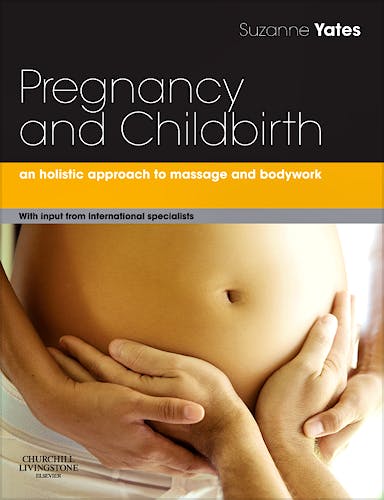

No hay productos en el carrito



Pregnancy and Childbirth. an Holistic Approach to Massage and Bodywork
Yates, Suzanne
1ª Edición Enero 2010
Inglés
Tapa blanda
224 pags
1400 gr
19 x 25 x 2 cm
ISBN 9780702030550
Editorial CHURCHILL LIVINGSTONE
LIBRO IMPRESO
-5%
47,95 €45,55 €IVA incluido
46,11 €43,80 €IVA no incluido
Recíbelo en un plazo de
7 - 10 días
LIBRO ELECTRÓNICO
-5%
36,39 €34,57 €IVA incluido
34,99 €33,24 €IVA no incluido
Acceso On Line
Inmediato
Description
Pregnancy and childbirth brings together, for the first time, western and eastern approaches providing a sound amalgamation of theoretical and practical information for bodywork practitioners world-wide. It describes in detail the application of massage and shiatsu from early pregnancy, including work during labour and for the first year postnatally for the mother.
This is a useful source of information for massage therapists, shiatsu practitioners, osteopaths, physical therapists, chiropractors, reflexologists, aromatherapists, acupuncturists, yoga and Pilates instructors.
Contents
Foreword
Preface
Acknowledgements
Contributors
Glossary
Introduction
Section 1: Theory – western and eastern
1 Western views of pregnancy
1.1 Changes for the pregnant woman
1.2 Reproductive system
1.3 Neuroendocrine system
1.4 Haemotological, haemostatic and cardiovascular systems
1.5 Musculoskeletal system
1.6 Respiratory system
1.7 Renal system
1.8 Gastrointestinal system
1.9 Immune, sensory, nervous, metabolic and integumentary systems
1.10 Embryonic development, fetal growth
1.11 Miscarriage
Reflective questions
References and further reading
2 Western theory of labour
2.1 Physiological basis of labour
2.2 Stages of labour
2.3 Fetal position/presentation
2.4 Maternal position
2.5 Changes in maternal and fetal systems during labour
2.6 Place of birth: home, hospital or birth centre, waterbirth
References
3 Western approach to the postpartum
3.1 Definition of postpartum period and overview of changes
3.2 Female reproductive system
3.3 Neuroendocrine system
3.4 Haemotological, haemostatic and cardiovascular systems
3.5 Musculoskeletal system
3.6 Respiratory system
3.7 Renal system, urinary tract, bladder
3.8 Other systems: gastrointestinal and hepatic, nervous, immune, sensory, integumentary
3.9 Infant feeding
3.10 Psychological state and postnatal depression
3.11 Summary and implications
References and further reading
4 Introduction to the eastern approach
4.1 Key theoretical concepts in eastern bodywork, including the importance of the extraordinary vessels in maternity care
References
5 Pregnancy from an eastern perspective
5.1 General energy patterns for the mother
5.2 Main energy changes and patterns during pregnancy for the mother
5.3 Energy patterns for the fetus
5.4 Changes in the extraordinary vessels
5.5 Changes in the 12 organs and meridians
5.6 Summary of main treatment principles
Reflective questions
References
Further reading
6 Labour from an eastern perspective
6.1 Main energy changes during birth: mother
6.2 Main energy changes during birth: baby
6.3 Changes in the extraordinary vessels: mother and baby
6.4 Changes in the 12 meridians: mother and baby
6.5 Summary of main treatment principles for work to support the natural birth process
Reflective questions
References
7 The postpartum from an eastern perspective
7.1 General energy patterns for the mother
7.2 Changes in the extraordinary vessels
7.3 Changes in the 12 meridians
7.4 Summary of main treatment principles
Reflective questions
References and further reading
Section 2: Practical bodywork
8 Introduction to bodywork
8.1 Assessment of the maternity client
8.2 Orthopaedic assessment and the maternity client
8.3 Positioning, draping and equipment
8.4 Prone, supine, semi-reclining, side-lying
8.5 Forward leaning and sitting
8.6 Definitions of techniques included in bodywork sections
8.7 Eastern bodywork concepts
8.8 The selection of the base; oil/lotions/wax and the use of essential oils in maternity care; aromatherapy
References and further reading
9 Practical bodywork in pregnancy
9.1 Overview and key themes
9.2 Specific considerations for each trimester
9.3 How to support women who are going through difficulties
9.4 Overview of practical techniques
9.5 Approaches and techniques for different parts of the body
9.6 Head, face, neck and shoulders
9.7 The back
9.8 Chest/abdomen and front of body: changes and working principles
9.9 Chest/abdomen and front of body: techniques
9.10 Legs and feet
9.11 Legs, feet, hands and arms: techniques
9.12 Lymphatic work
References and further reading
10 Practical bodywork in labour
10.1 Overview of practical labour work themes
10.2 Birth preparation work
10.3 Specific considerations for supporting different stages of labour
10.4 Bodywork techniques for different stages of labour
10.5 Approaches and techniques for different areas of the body
Reflective question
References and further reading
11 Practical bodywork in the postpartum
11.1 Benefits of postnatal work
11.2 Overview of practical postnatal work themes
11.3 Specific considerations for supporting different postnatal periods
11.4 Cautions in the early postnatal period
11.5 Overview of practical techniques and their suitability at different stages postnatally
11.6 Approaches and techniques for different areas of the body
11.7 Working with scars
References and further reading
12 Aftercare and self-care
12.1 Benefits of aftercare
12.2 Breathing and visualisation
12.3 Exercise
12.4 Touch, including shiatsu and massage
Reflective questions
References
13 The medical approach to labour
13.1 The medical model of labour
13.2 Monitoring in labour
13.3 Induction
13.4 Pain relief
13.5 Assisted delivery
13.6 Management of the third stage
Reflective questions
References and further reading
14 Working with higher risk maternity clients
14.1 Definition of ‘higher risk’ pregnancy
14.2 Medical conditions existing prior to pregnancy
14.3 Issues arising during pregnancy
14.4 Chromosomal and developmental abnormalities of the fetus
14.5 Complications of labour and delivery
References
15 Professional issues
15.1 Setting up a maternity-focused bodywork practice
Reflective exercise
15.2 Scope of practice: the bodyworker as maternity care provider
Reference
Appendix 1: Useful contacts and resources
Index
Author Information
By Suzanne Yates, BA(Hons), Dip HSEC(Shiatsu diploma), MRSS(T), APNT, Antenatal and postnatal exercise instructor, PGCE(PCET), Director of Well Mother - Education for Maternity Care, Bristol, UK
© 2025 Axón Librería S.L.
2.149.0